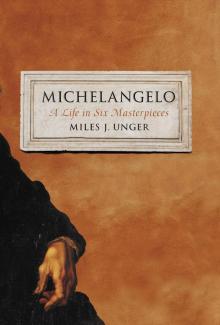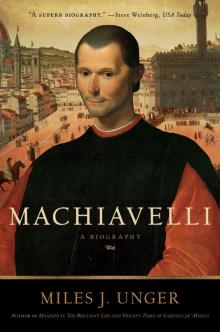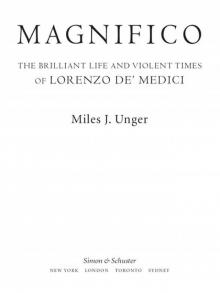- Home
- Miles J. Unger
Magnifico
Magnifico Read online
ALSO BY MILES J. UNGER
The Watercolors of Winslow Homer
SIMON & SCHUSTER
1230 Avenue of the Americas
New York, NY 10020
Copyright © 2008 by Miles J. Unger
All rights reserved, including the right to reproduce this book or portions thereof in any form whatsoever. For information address
Simon & Schuster Subsidiary Rights Department,
1230 Avenue of the Americas,
New York, NY 10020.
SIMON & SCHUSTER and colophon are registered trademarks of Simon & Schuster, Inc.
Maps by Paul J. Pugliese
Library of Congress Cataloging-in-Publication Data
Unger, Miles.
Magnifico: the brilliant life and violent times of Lorenzo de’ Medici / Miles J. Unger.
p. cm.
Includes bibliographical references.
1. Medici, Lorenzo de’, 1449–1492. 2. Florence (Italy)—History—1421–1737. 3. Statesmen—Italy—Florence—Biography. 4. Intellectuals—Italy—Florence—Biography. 5. Florence (Italy)—Biography. I. Title.
DG737.9.U54 2008
945'.51105092—dc22
[B] 2007027669
ISBN-13: 978-1-4165-4510-1
ISBN-10: 1-4165-4510-7
Visit us on the World Wide Web:
http://www.SimonSays.com
In memory of my mother, Bernate,
whose adventurous spirit lies behind this book
CONTENTS
List of Illustrations
Maps
I • The Road from Careggi
II • Family Portrait
III • Master of Ceremony
IV • Hope of the City
V • Devil’s Paradise
VI • Games of Fortune
VII • Lord of the Joust
VIII • A Wedding and a Funeral
IX • Master of the Shop
X • Fat Victory
XI • Domestic Tranquillity
XII • The Shadow of Rome
XIII • Under the Sign of Mars
XIV • Conspiracy
XV • Murder in the Cathedral
XVI • The Bloodstained Pavement
XVII • Neapolitan Gambit
XVIII • The Shadow Lifts
XIX • The Garden and the Grove
XX • The Cardinal and the Preacher
Epilogue: The Spirit in the Ring
Medici Family Tree
Note on the Government of Florence in the Age of Lorenzo
Notes
Bibliography
Photographic Insert
LIST OF ILLUSTRATIONS
I. THE ROAD FROM CAREGGI: The Medici Villa at Careggi (Miles Unger)
II. FAMILY PORTRAIT: The Baptistery of San Giovanni, Florence (Miles Unger)
III. MASTER OF CEREMONY: Benozzo Gozzoli, Adoration of the Magi (detail of Lorenzo), Medici Palace, 1459 (Art Resource)
IV. HOPE OF THE CITY: Workshop of Agnolo Bronzino, Cosimo de’ Medici, 16th century (Art Resource)
V. DEVIL’S PARADISE: Mino da Fiesole, Bust of Piero de’ Medici, 1453 (Art Resource)
VI. GAMES OF FORTUNE: Filippo Brunelleschi and Bartolomeo Ammanati, Palazzo Pitti (Garden View), early 15th and late 16th centuries (Art Resource)
VII. LORD OF THE JOUST: School of Giorgio Vasari, Joust in Santa Croce, 16th century (Art Resource)
VIII. A WEDDING AND A FUNERAL: Andrea del Verrocchio, Tomb of Giovanni and Piero de’ Medici, c. 1470 (Art Resource)
IX. MASTER OF THE SHOP: Domenico Ghirlandaio, Annunciation to Zachariah (detail) showing Marsilio Ficino, Cristoforo Landino, Angelo Poliziano, and Gentile Becchi, 1483–86, Sta. Trinita (Art Resource)
X. FAT VICTORY: Piero della Francesca, Federico da Montefeltro, c. 1465 (Art Resource)
XI. DOMESTIC TRANQUILLITY: Giusto Utens, Medici Villa at Trebbio (Art Resource)
XII. THE SHADOW OF ROME: Melozzo da Forli, Pope Sixtus IV Appointing Platina, 1477 (Art Resource)
XIII. UNDER THE SIGN OF MARS: Workshop of Luca della Robbia, Pazzi Arms, 16th century (Art Resource)
XIV. CONSPIRACY: After Andrea del Verrocchio, Bust of Lorenzo il Magnifico, 1478 (National Gallery of Art)
XV. MURDER IN THE CATHEDRAL: Antonio and Piero Pollaiuolo, Galeazzo Maria Sforza, 1471 (Art Resource)
XVI. THE BLOODSTAINED PAVEMENT: Sandro Botticelli, Giuliano de’ Medici, after 1478 (Art Resource)
XVII. NEAPOLITAN GAMBIT: Francesco Pagano, Port of Naples, 15th century (Art Resource)
XVIII. THE SHADOW LIFTS: Andrea del Verrocchio, Bust of Piero de’ Medici, the Unfortunate, c. 1490 (Art Resource)
XIX. THE GARDEN AND THE GROVE: Michelangelo, Battle of Lapiths and Centaurs, 1492 (Art Resource)
XX. THE CARDINAL AND THE PREACHER: Fra Bartolomeo, Portrait of Girolamo Savonarola, c. 1498 (Art Resource)
EPILOGUE: THE SPIRIT IN THE RING: Raphael, Pope Leo X, Giovanni de’ Medici, with Cardinals Giulio de’ Medici and Luigi de’ Rossi, 1517 (Art Resource)
The Medici Villa at Careggi (Miles Unger)
I. THE ROAD FROM CAREGGI
“[I]t is necessary now for you to be a man and not a boy; be so in words, deeds and manners.”
—PIERO DE’ MEDICI TO LORENZO, MAY 11, 1465
LATE ON THE MORNING OF AUGUST 27, 1466, A SMALL group of horsemen left the Medici villa at Careggi and turned onto the road to Florence. It was a journey of three miles from the villa to the city walls along a meandering path that descended through the hills that rise above Florence to the north. Dark cypresses and hedges of fragrant laurel lined the road, providing welcome shade in the summer heat. Through the trees the riders could catch from time to time a glimpse of the Arno River flashing silver in the sun.
On any other day this would have been a relaxing journey of an hour or so, the heavy August air encouraging a leisurely pace, the beauties of the Tuscan countryside inspiring laughter and conversation among the young men. “There is in my opinion no region more sweet or pleasing in Italy or in any other part of Europe than that wherein Florence is placed,” wrote a Venetian visitor, “for Florence is situated in a plain surrounded on all sides by hills and mountains…. And the hills are fertile, cultivated, pleasant, all bearing beautiful and sumptuous palaces built at great expense and boasting all manner of fine features: gardens, woods, fountains, fish ponds, pools and much else besides, with views that resemble paintings.”
But today, the mood was somber. The men peered nervously from side to side, fingering the pommels of their swords. Gnarled olive trees, ancient and silver-leaved, hugged terraces cut into the slopes, and parallel rows of vines glistening with purple grapes gave the hills a tidy geometry worthy of a fresco by Fra Angelico.
Taking the lead was a young man who rode with the easy grace of a born horseman. His appearance was distinctive, though not at first glance particularly attractive. Above an athletic frame, bony and long-limbed, was a rough-hewn face. His nose, which was flattened and turned to the side as if it had once been broken, gave him something of the look of a street brawler, and the prominent jaw that caused his lower lip to jut out pugnaciously did nothing to soften this impression. Beneath heavy brows peered black, piercing eyes more suggestive of animal cunning than refined intelligence. Dark hair, parted in the middle, hung down to his shoulders, providing a stern frame to the irregular features. Even a close friend, Niccolò Valori, was forced to admit that “nature had been a step-mother to him with regard to his personal appearance. [N]onetheless,” continued Valori, “when it came to the inner man she truly acted as a kindly mother…. [A]lthough his face was not handsome it was full of such dignity as to command respect.”*
This homely face belonged to Lorenzo, the seventeen-year-old son and heir of Piero de’ Medici. S
ince the death of Lorenzo’s grandfather Cosimo, two years earlier, Piero had taken over the far-flung Medici banking empire, a position that made him one of the richest men in Europe. But it was not wealth alone that made the Medici name famous throughout Europe. The Medici, though they possessed no titles, were regarded by those unfamiliar with the intricacies of local politics as kings in all but name of the independent Florentine Republic, which, though small compared with the great states of Europe, dazzled the civilized world through the brilliance of her art and the vitality of her intellectual life.† Not many generations removed from their peasant origins, the Medici spent lavishly on beautifying their city in the expectation that at least some of its glamour would rub off on its first family.
It was Cosimo who had parlayed his apparently inexhaustible fortune into a position of unprecedented authority in the state. On his tombstone in the family church of San Lorenzo were the words Pater Patriae (“Father of His Country”), bestowed on him by a grateful public for his wise stewardship and generous patronage of the city’s civic and religious institutions. Cosimo had dominated the councils of government through the force of his personality and his willingness to open his own coffers when the state was short of cash. Florentines, like modern-day Americans, had a healthy respect for money and seemed to feel that those who showed a talent for amassing it must possess other, less visible virtues. Cosimo rarely held high political office, happy to let others enjoy the pomp of life in the Palazzo della Signoria as long as important decisions were left in his hands.* For a time the gratitude Florentines felt toward Cosimo earned for his son Piero the allegiance of a majority of the citizens, and, until recent troubles, it had been generally assumed that this crucial position as the leading figure in the reggimento—the regime that really ran Florence, whoever temporarily occupied the government palace—would one day pass to the young man now guiding his small band along the road to Florence.
On this August morning, however, the fate of the Medici and their government seemed to teeter on a knife’s edge. The ancient constitution of the republic, in which the governing of the state had been shared widely among the city’s wealthy and middle-class citizens, had been undermined by this single family’s rise to prominence.† The heavy-handed tactics they used to win and to wield power had stirred up resentment as once proud families saw themselves reduced to little more than servants of the Medici court.
But now a group of rich and influential men saw an opportunity to strike back. The various factions that normally made Florentine politics a lively affair had been secretly arming themselves for months. Rumors of foreign armies on the march—a different one for each side in the contest—increased the general paranoia until it seemed as if the smallest incident might touch off a general conflagration.
On one side were the Medici loyalists, the Party of the Plain (named for the site of the Medici palace on low-lying land on the north bank of the Arno), who favored the current system, which they claimed had brought decades of peace and prosperity. On the other was the Party of the Hill, centered on Luca Pitti’s palace on the high ground to the south, who pointed out that Medici ascendance had been purchased at the expense of the people’s traditional liberty. The most visible figures in the rebellion were former members of Cosimo’s inner circle whose democratic zeal, not much in evidence in recent years, was rekindled by the humiliating prospect of having to take orders from his son. Few of them, in fact, had sterling reformist credentials. Most had connived with Cosimo in his systematic undermining of republican institutions, but now they adopted as their own the slogan “Popolo e Libertà!” (the “People and Liberty!”).
Discontent with the despotic tendencies of the government was not the only factor precipitating the current crisis. The perceived weakness of the fifty-year-old Piero contributed to a general sense that the regime was not only corrupt but, perhaps even worse, adrift. Even before Cosimo’s death in 1464 the influential Agnolo Acciaiuoli, now one of the leaders of the Hill, complained that Cosimo and Piero had become “cold men, whom illness and old age have reduced to such cowardice that they avoid anything that might cause them trouble or worry.” The citizens of Florence, said the uncharitable Niccolò Machiavelli some years later, “did not have much confidence in [Cosimo’s] son Piero, for notwithstanding that he was a good man, nonetheless, they judged that…he was too infirm and new in the state.”
Even many of Piero’s supporters shared that gloomy assessment. From his youth, Piero (known to history as il Gottoso, the Gouty) had been plagued by the family ailment that rendered him for long periods a virtual prisoner in his own house. It was a disease that affected not only his body but his temper. The architect Filarete wrote in his biographical sketch of the Medici leader, “those who have [gout] are usually rather acid and sharp in their manner,” but that while “few can bear its pains…[Piero] bears it with all the patience he can.” Piero also lacked his father’s common touch, the earthy humor that endeared Cosimo to the city’s humbler elements. (Once when a petitioner, hoping to reform the sagging morals of the city, begged Cosimo to pass a law prohibiting priests from gambling, the practical Cosimo replied, “First stop them from using loaded dice.” ) Piero, by contrast, was an aesthete and connoisseur who liked nothing better than to retire to his study, where he could gaze at his fine collection of antique busts, ancient manuscripts, and rare gemstones.
Citizens complained that policy was hatched in the privacy of the Medici palace on the Via Larga, rather than in open debate at the Palace of the Priors, as the sickly Piero was often forced to meet with his trusted lieutenants over dinner in his house or in his bedchamber. Such a reserved and quiet man was unlikely to appeal to the pragmatic merchants of Florence, who approached politics in much the same lively spirit as they entered the city’s marketplaces, eager to buy and sell, to argue and cajole, to win an advantage if possible but in any case to strike deals and shake hands at the conclusion of a bargain hard driven but mutually beneficial. In both the Palace of the Priors and in the Mercato Vecchio (the Old Market in the heart of the city), relations of trust built on face-to-face encounters were more important than abstract ideology. Piero was an intensely private man in a world that valued above all the lively give-and-take of the street corner.
The best contemporary portrait of Piero is the fine marble bust by Mino da Fiesole.* The sculpture reveals a handsome man with the cropped hair of an ancient Roman patrician and alert, thoughtful eyes. But there is something in the pugnacious thrust of his chin, a feature passed down to his oldest son, that suggests an inner strength his contemporaries little suspected.
A more engaging portrait emerges in Piero’s private letters that reveal a conscientious man deeply attached to his family and continually fretting over their uncertain future. He was a loving and devoted husband to Lucrezia Tornabuoni, a descendant of one of Florence’s most ancient families, and their correspondence reveals an unusually close bond. “[E]very day seems a year until I return for your and my consolation,” wrote Lucrezia from Rome to Piero, while Piero confessed that he awaited her arrival “with infinite longing.”
Piero was also a devoted, if sometimes overbearing, father, particularly with his oldest son, who could not leave town without being pursued by letters filled with unsolicited advice and constructive criticism. Piero’s letters alternately exhibit pride in his son’s precocious ability and an almost neurotic need to interfere in the smallest details of his conduct. “You will have received my letter of the 4th,” he wrote to Lorenzo in Milan, “telling you what conduct to pursue, all of which remember; in a word, it is necessary now for you to be a man and not a boy; be so in words, deeds and manners.” For the most part Lorenzo took his father’s nagging in good humor, though occasionally his exasperation shows through, as when he responded to yet another request for information, “I wrote to you two days ago, and for this reason I have little to say.”
The leaders of the current revolt were all prominent figures of the reggimento who viewed C
osimo’s death as an opportunity to satisfy their own ambition. Those like Agnolo Acciaiuoli, who had suffered exile with Cosimo when he ran afoul of the then ruling Albizzi family and shared in his triumphant return in 1434, felt that after thirty years of loyal service to the Medici cause their time had come. “Piero was dismayed when he saw the number and quality of the citizens who were against him,” wrote Machiavelli some sixty years after the events in his Florentine Histories, “and after consulting with his friends, he decided that he too would make a list of his friends. And having given the care of this enterprise to some of his most trusted men, he found such variety and instability in the minds of the citizens that many of those listed as against him were also listed in his favor.”
Machiavelli’s account captures something of the confusion of those days as once trusted friends were suspected of secret treachery. Considering the formidable array of figures now agitating for change, a betting man might have thought twice before wagering a few soldi on the Medici cause. They included such prominent and respected citizens as Luca Pitti, who, at least in his own mind, was Cosimo’s logical successor; the gifted orator Niccolò Soderini; Agnolo Acciaiuoli, a scholar and a friend of Cosimo’s whose thoughtful views carried great weight with his fellow citizens; and Dietisalvi Neroni, a shrewd political operator who had been a fixture within the highest circles of the reggimento.
In secret nighttime meetings in the city’s sacred buildings—the Party of the Plain favoring the monastery La Crocetta, while their adversaries favored the equally pious La Pietà—men began to look to their own defense, each suspecting the other of plotting the overthrow of the constitutional government. In a typically Florentine mixture of the sacred and profane, fervent prayers to the Virgin were often followed by calls to riot and mayhem.

 Michelangelo
Michelangelo Machiavelli
Machiavelli Magnifico
Magnifico